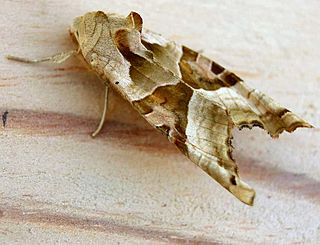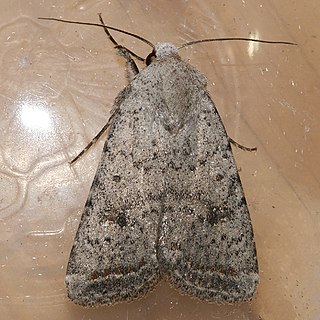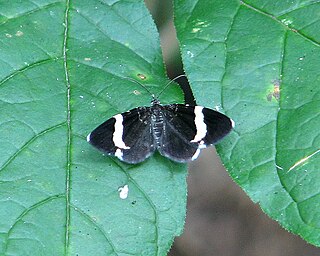
Nicotiana is a genus of herbaceous plants and shrubs in the family Solanaceae, that is indigenous to the Americas, Australia, Southwestern Africa and the South Pacific. Various Nicotiana species, commonly referred to as tobacco plants, are cultivated as ornamental garden plants. N. tabacum is grown worldwide for the cultivation of tobacco leaves used for manufacturing and producing tobacco products, including cigars, cigarillos, cigarettes, chewing tobacco, dipping tobacco, snuff, and snus.

The small angle shades is a moth of the family Noctuidae. It is distributed throughout the Palearctic. The species was first described by Carl Linnaeus in his 1758 10th edition of Systema Naturae.

The angle shades is a moth of the family Noctuidae. The species was first described by Carl Linnaeus in his 1758 10th edition of Systema Naturae. It is distributed throughout Europe as far east as the Urals and also in the Azores, in Algeria, and in Asia Minor, Armenia, and Syria. It is strongly migratory.

The Caradrinini are a mid-sized tribe of moths in the family Noctuidae.
Madeuplexia is a genus of moths of the family Noctuidae from Madagascar. The genus was erected by Pierre Viette in 1960.

Phlogophora is a genus of moths of the family Noctuidae first described by Georg Treitschke in 1825.

Trichodezia is a genus of moths in the family Geometridae described by Warren in 1895.

Phlogophora scita is a moth of the family Noctuidae. It is found in most countries of continental Europe, from France to Belarus, Ukraine and Turkey, and from Germany and Poland to Italy and Greece In the Alps it is found up to heights of 1,600 meters.

Phlogophora periculosa, the brown angle shades, is a moth of the family Noctuidae. It is found from coast to coast in the northern United States and southern Canada, south in the east to Georgia and Mississippi, south in the west to California.

Azygophleps is a genus of moths belonging to the family Cossidae.
Azygophleps albovittata is a moth in the family Cossidae. It is found in Nigeria, Ghana, Uganda, the Democratic Republic of the Congo, Kenya, Guinea and Zimbabwe.

Trichodezia albovittata, the white-striped black moth, is a moth in the family Geometridae. It is found from Alaska to Newfoundland and Labrador, south in the east to North Carolina and in the west to northern California.

Phlogophora conservuloides is a species of moth of the family Noctuidae. It is found from Sikkim to Taiwan.
Pammeces is a genus of moths in the family Agonoxenidae. It was formerly included in the Cosmopterigidae.
Pammeces phlogophora is a moth of the family Agonoxenidae. It was described by Walsingham in 1909. It is found in Panama.

Phlogophora calamistrata is a species of moth of the family Noctuidae first described by Frederic Moore in 1882. It is found in India.

Hypsosinga albovittata is an orb-weaver spider species, found in the Palearctic.

Phlogophora iris, the olive angle shades, is a species of cutworm or dart moth in the family Noctuidae. It is found in North America.
Phycidopsis albovittata is a moth of the family Notodontidae first described by George Hampson in 1893. It is found in Sri Lanka, India, Sundaland, Luzon in the Philippines and Sulawesi.

Stethojulis albovittatus, the blueline wrasse, whitelined wrasse or rainbowfish, is a species of marine ray-finned fish, a wrasse from the family Labridae. It is reef-dwelling fish that feeds on small invertebrates. It occurs in the Indian Ocean from the Red Sea as far south as South Africa to the islands of Bali and Sumatra. This species is found over reef flats, in clear lagoon and seaward reefs where it feeds diurnally on small invertebrates, particularly on crustaceans and molluscs. It has also been recorded over rocky areas in Réunion, as well as in seagrass beds off Mozambique. It is found solitarily or in small groups made up of one male and a small number of females.













